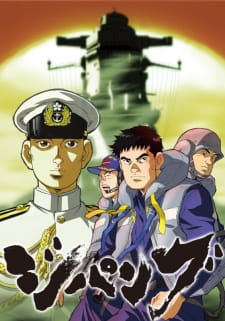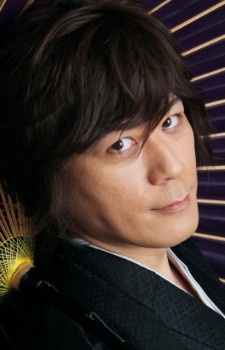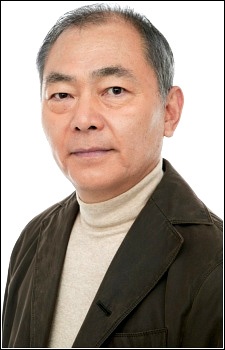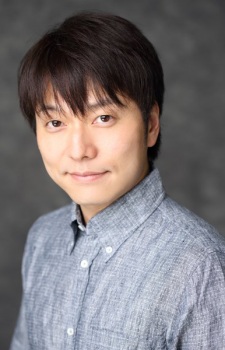
Zipang
Summary: A Ripple in Time Turns the Crucial Tide of WWII.
Scheduled for routine military exercises, Commander Kadomatsu and the crew of Japan's newest and most modern Battlecruiser, The Mirai, are ready to test out the ship's state-of-the-art Aegis System. Instead, they find themselves transported back to June 4th, 1942—date of the crucial Battle of Midway, where the Japanese fleet was dealt a crippling blow. When an overzealous Kadomatsu rescues one of the battle's victims, Kusaka, from a sinking zero fighter, the Mirai's fate is sealed. The crew pledges not to do anything to alter the past further. However, they're now forced to fight a U.S. submarine in a battle that should never have occurred. Thus setting off a chain of events that may forever change the flow of history!
(Source: Geneon Entertainment USA, edited)
Description
A Ripple in Time Turns the Crucial Tide of WWII.
Scheduled for routine military exercises, Commander Kadomatsu and the crew of Japan's newest and most modern Battlecruiser, The Mirai, are ready to test out the ship's state-of-the-art Aegis System. Instead, they find themselves transported back to June 4th, 1942—date of the crucial Battle of Midway, where the Japanese fleet was dealt a crippling blow. When an overzealous Kadomatsu rescues one of the battle's victims, Kusaka, from a sinking zero fighter, the Mirai's fate is sealed. The crew pledges not to do anything to alter the past further. However, they're now forced to fight a U.S. submarine in a battle that should never have occurred. Thus setting off a chain of events that may forever change the flow of history!
(Source: Geneon Entertainment USA, edited)
Zipang Pictures
Zipang Review
Zipang — A Ripple in Time Turns the Crucial Tide of WWII. This overview is intentionally spoiler-free and focuses on tone and intent rather than plot specifics.
Thematically, It sits firmly within Action, Drama, Sci-Fi conventions as a TV work and has garnered attention (MAL score: 7.49). This work explores character dynamics, tonal shifts, and the interplay between narrative ambition and execution. The story's pacing and tonal choices are crafted to complement the central ideas, often emphasizing atmosphere and emotional truth over explicit exposition. The show's ability to evoke a consistent mood — whether melancholic, exuberant, or contemplative — is a recurring strength, and the scenes are constructed so viewers can infer stakes without needing explicit spoilers.
Characterization is a core pillar here. Protagonists and supporting figures are written with distinct motivations and narrative roles; even when archetypal, the series invests in small behavioral details that make choices feel earned. Character arcs are handled with an eye for gradualism: development often arrives through incremental beats rather than abrupt, expository shifts. The interactions between characters create texture, and relationships are used to illuminate both personal flaws and larger thematic concerns.
On the visual front, production values play a significant role. The animation quality varies by sequence but frequently showcases thoughtful direction and composition. Background art, framing, and color palettes are used deliberately to support tone — quieter scenes favor muted palettes while action or heightened emotional beats employ brighter, more kinetic visuals. Direction choices, such as camera movement and shot selection, often elevate scenes beyond their raw script, creating moments that linger in the viewer's mind.
The soundscape — score, incidental music, and sound design — complements the visual language. Music cues are placed to maximize emotional resonance without manipulating the audience with melodrama; this restraint often leads to more authentic emotional payoff. Sound design punctuates key moments, and when the series leans on silence, those quieter moments are given weight by measured audio choices.
Pacing and structure are handled with craft. Episodes are arranged to build tension and release methodically, and the narrative rarely rushes through important emotional beats. That said, the deliberate pacing may feel slow to viewers who prefer faster plot turnover; the reward is greater nuance and an accumulation of meaning across the series. Accessibility is generally good — one can appreciate surface-level pleasures, while repeat or attentive viewing reveals additional layers.
No title is without flaws. Occasional unevenness in subplots or variable animation across episodes can be distracting. Some tonal shifts might feel abrupt if you expect uniformity; others will argue that those shifts are purposeful. These are worth noting, but they seldom undercut the larger achievements of the work.
In sum, Zipang offers a rich experience for viewers who value character-driven storytelling, considered visual design, and a soundtrack that supports rather than overwhelms. For fans of Action, Drama, Sci-Fi, this is an especially rewarding watch. It's recommended for those who appreciate layered narratives and artistry in animation, and best approached with patience and attention to nuance.
Characters & Voice Actors

Kadomatsu, Yosuke
Main

Kadomatsu, Yosuke
Main

Kusaka, Takumi
Main

Kusaka, Takumi
Main

Umezu, Sabure
Main

Umezu, Sabure
Main

Ishiwara, Kanji
Supporting

Ishiwara, Kanji
Supporting

Katagiri
Supporting

Kikuchi, Masayuki
Supporting

Kikuchi, Masayuki
Supporting

Momoi, Sachiko
Supporting

Momoi, Sachiko
Supporting

Oguri, Kouhei
Supporting

Oguri, Kouhei
Supporting

Taki, Eiichirou
Supporting

Tsuda, Kazuma
Supporting

Tsuda, Kazuma
Supporting

Tsuda, Kazuma
Supporting

Yamamoto, Isoroku
Supporting
Staff

Iijima, Kouji
Producer

Naruke, Yoshinori
Producer

Furuhashi, Kazuhiro
Director, Script, Storyboard, Series Composition

Hiramitsu, Takuya
Sound Director

Hiramuki, Tomoko
Episode Director

Matano, Hiromichi
Episode Director, Storyboard

Matsushita, Yukihiro
Episode Director, Storyboard

Okamoto, Hideki
Episode Director

Takeda, Yuuichirou
Script

Kodera, Katsuyuki
Storyboard

Nishimura, Hiroyuki
Storyboard

Soeta, Kazuhiro
Storyboard, Animation Director

Yamanaka, Eiji
Storyboard

AUDIO RULEZ
Theme Song Performance

BEGIN
Theme Song Lyrics, Theme Song Composition, Theme Song Performance, Theme Song Arrangement

Endou, Eiichi
Key Animation

Fujii, Fumino
Key Animation

Hiruma, Takashi
Background Art

Karatani, Ayako
Key Animation

Kasahara, Akira
Animation Director